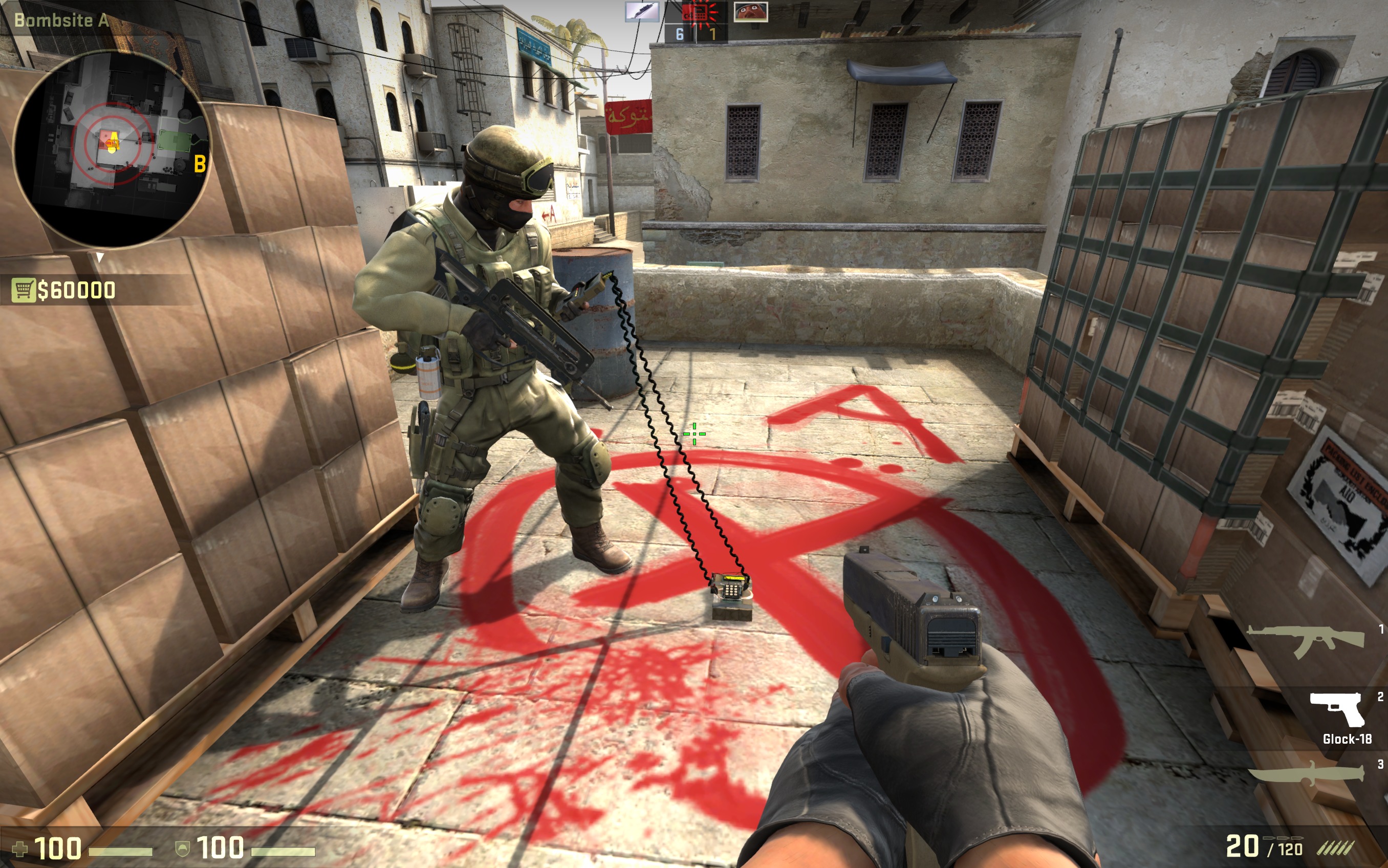Understanding the big changes in CS:GO's latest patch

We write about FPSes each week in Triggernometry, a mixture of tips, esports, and a celebration of virtual marksmanship.
Beneath Counter-Strike’s skin is a skeleton of interconnected systems: movement, location-specific damage modeling, and weapon behavior, to name a few. In last week’s major patch release Valve swapped out some significant bones in that skeleton. With a foundation built on a decades-old legacy favoring tradition over radical change, CS:GO’s community has appraised this update as nothing short of historic. Beyond bug fixes, the meat of the patch delivers significant adjustments to CS:GO’s steadfast core: hitboxes, animations, and weapon behavior. Here’s how these changes affect the game—for casuals, pros, and skin-conomists alike—and why they’re important milestones in one of PC gaming’s most storied shooters.
Hitbox comparison image by imgur user “whats0n”
Hitboxes
CS:GO’s long-lasting cuboid hitboxes—the invisible, body-hugging shapes critically governing bullet hit detection—has morphed into a “capsule” set with a more cylindrical configuration that better covers each part of the CT and T model. Each cylinder conforms to the body model’s shape more closely than the hard edges of a cube, and the entire set provides a higher degree of overlap for accordingly increased precision in determining where incoming bullets should land (and, subsequently, how much damage is meted out). Valve also fixed inconsistent hitbox alignment that tended to crop up during certain movements such as jumping or hanging on ladders by forcing hitbox rigs to continuously shape to whatever motion the model is performing at all times: running, standing still, climbing, planting the bomb, and so on.
Why it matters: At long last Valve has repaired CS:GO’s an issue that’s plagued the community for years. Dozens of demonstrations of misaligned hitboxes filled forum threads and Reddit posts. Some examples were hilariously blatant, some were more analytical, but they all pointed to a harmful obstacle of CS:GO’s layers of strategy and skill. The now-continually synchronized hitboxes ensures shots will land precisely where they’re sent to, and we can finally send a farewell salute to the unwelcome immortal bomb-planter.
One interesting phenomenon to note is how the development and proliferation of the professional scene flourished in the face of faulty hitboxes. Pro teams, by virtue of their intimate knowledge of each minute aspect of the game, were acutely aware of how hit detection affected performance; they simply adapted and got used to it. Teams with star-led rosters such as Fnatic and EnVyUs will re-adapt in short time, but it’ll be interesting to observe the process of unlearning years of habits.
In theory, position control should turn even more rewarding for quick multi-frags with steady spray. Given the heightened payoff for shooting accuracy, 1v1 encounters will swing towards whoever is on the draw the fastest for tapping shots into the larger head hit-bubble. No longer is jump-peeking a safeguarded method for gathering intel, as it’s now an exposing move with a heavy risk of a blink-and-gone reflex kill.
Animations
New and improved animations for the worldview character model (the models of teammates and enemy players seen from your view) smooths out walking/running cycles and gives more natural physical behavior to the weapons and equipment adorning each model. In particular, full draw animations replace the former, jerky ones for guns and grenades, and switching items plays a neat holster sequence for whatever’s being put away. Ladder climbing looks better but still hasn’t lost the comedic awkwardness of watching someone sprinting up a vertical surface while gripping a rifle with both hands.
Player and weapon models will also cull when up against a thin wall or doorway. That means any portion of the model that would stick out is automatically cut away to avoid erroneous clipping and unintentional giveaways from simply standing too close.
Keep up to date with the most important stories and the best deals, as picked by the PC Gamer team.
Why it matters: Though mostly cosmetic, the new animations better represent what a spotted player is doing moment to moment. Stronger-colored defusal kits are easier to pick out on the model, and cleaner-looking transitions to secondaries impart an important sign that an opponent’s primary has run dry. Reports of distorted models and players flopping on the ground have also surfaced in the days following the update.
Model culling is a pretty significant boon for ambush-oriented players parking up against high-traffic chokepoints such as Nuke’s squeaky and Dust 2’s double doors. It doesn’t completely cover all angles—the tight corners of Inferno’s banana still occasionally betray a popped-out barrel or two, for instance—but it does add fair variability to close-quarter positions typically avoided for wonky clipping. In a way it’s more of a buff for the Terrorists, who now have to worry less about their barrels sticking through a door and signaling their attack.

Defusals
Many a round of CS:GO ends end with a solitary CT crouching over the beeping bomb. The patch majorly modifies that intimate man-on-explosive encounter by placing a multimeter in the defuser’s hands with clearly visible cables running into the bomb while it’s being defused. That’s probably the most obvious “Hey, I’m interacting with this” sign Valve could apply without breaking realism—defusers now look like military Spider-Men.
Why it matters: Ninja and fake-out defusals are integral to strategic CS:GO play. The inclusion of the cables’ huge visual marker lowers the effectiveness of baiting bomb-guarding Ts into a surprise riposte. (One pro player even suggests cables be a spectator-side feature only.) Ts can now check for cables on a shoulder-peek to determine if the defuse is true or not, but savvy CTs can set up for the next peek knowing that brandishing cables will likely draw out an opponent for a 1v1. A sneaky CT swooping in for the ninja defuse is still possible, but it’ll be much harder to pull off with Ts having more concrete information on when an actual defuse is happening.

M4A1-S
The silenced M4A1-S, a CT staple, has seen its fire rate reduced to a flat 600 RPM along with a slight increase to base bullet spread. Its price has dropped $100 to $3,100, a reversal of the cost hike implemented in the March 31 patch. Its armor penetration value has also shrunk by roughly 10 percent, but plenty posters have indicated the old value still accidentally exists in the live version.
Why it matters: Many players consider these changes as the M4A1-S’ death-knell, but the rifle’s true fate isn’t so cut-and-dried. Indeed, pro player input is predictably divisive. The M4A1-S now fires at the same rate as the AK, a noticeable dip in damage output for close-range combat. Interestingly, the slower fire provides a higher amount of recoil decay in between each shot which leads to tighter handling at farther distances. It’s easy to assume the M4A4, the unsilenced high-ammo brother to the M4A1-S, will claim the go-to CT gun crown, but the A1 will find use as an easily controllable brain-tapper at range.
Pistols
The flashy dual Berettas got a boost to armor penetration and range, both understandable buffs to bring the rarely glimpsed pistol choice in line with common handcannons. The Zeus taser has had its cost reduced to a miniscule $100 as a value buy for instant kills up close.
Why it matters: Pistol changes invariably carry an economic ripple effect into later rounds of a match via shakeups in the eco meta. Although the likelihood of a drilled team adopting dualies over the reliability of the Tec-9, Five-Seven, or P250 is low, these modifications make the Berettas a safe buy during pistol rounds. Its extra armor penetration is good insurance against early round armor as they’ll dome an unhelmeted player in one hit. We’ll see the Zeus show up more often in loadouts due to its cheap price, but its usefulness still stays niche as a silly method for taking out a solitary player. Zeus skins are inevitable.

PC Gamer Pro is a new channel dedicated to esports and competitive gaming. Check back every day for exciting, fun and informative articles about League of Legends, Dota 2, Hearthstone, CS:GO and more. GL HF!
Omri Petitte is a former PC Gamer associate editor and long-time freelance writer covering news and reviews. If you spot his name, it probably means you're reading about some kind of first-person shooter. Why yes, he would like to talk to you about Battlefield. Do you have a few days?


